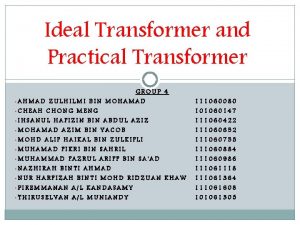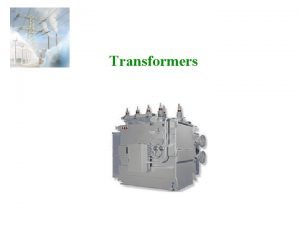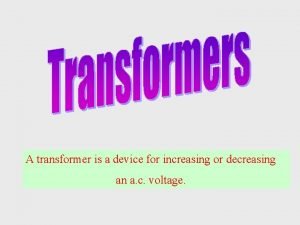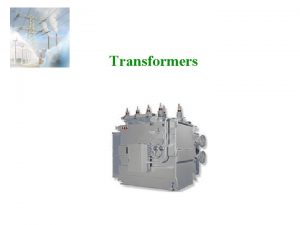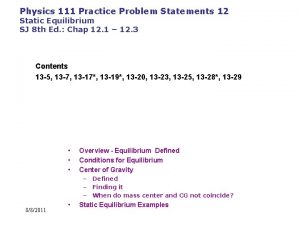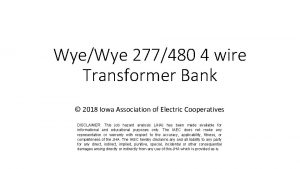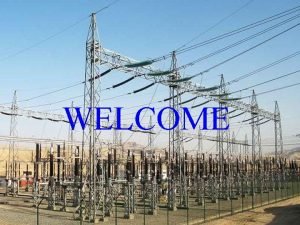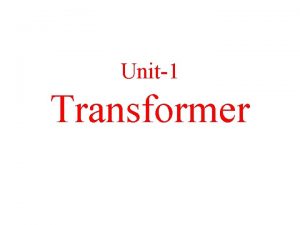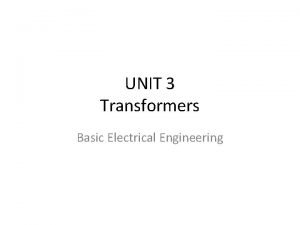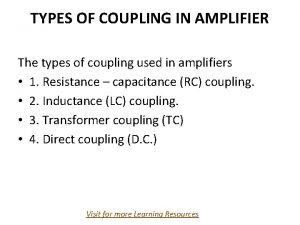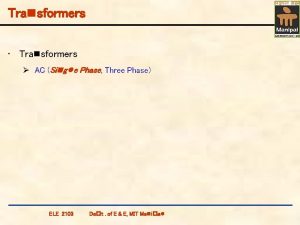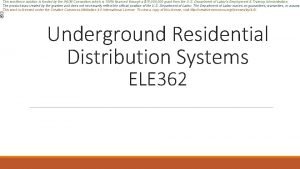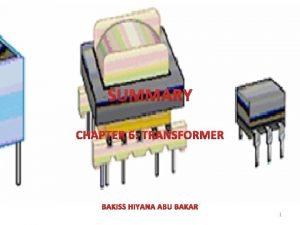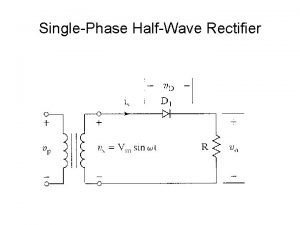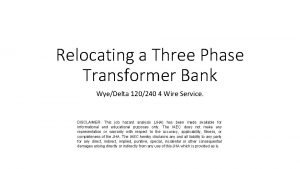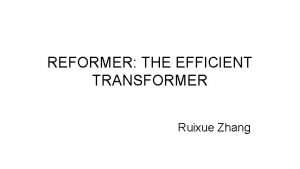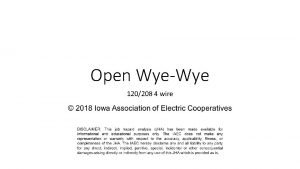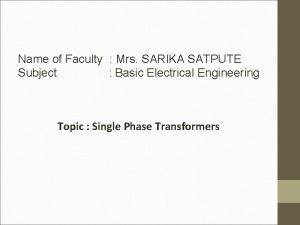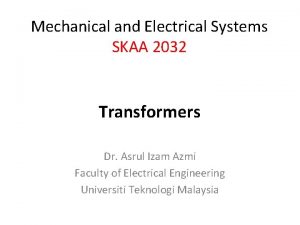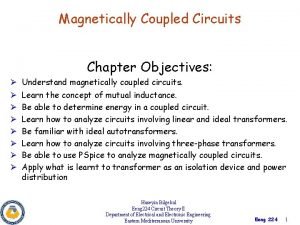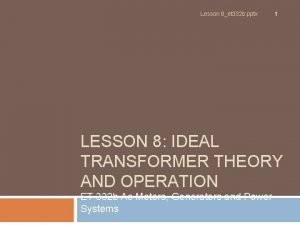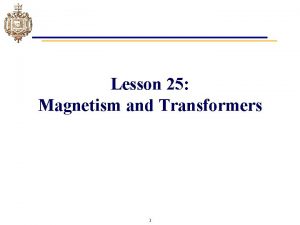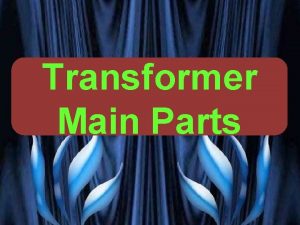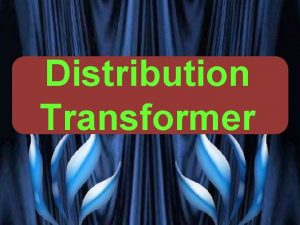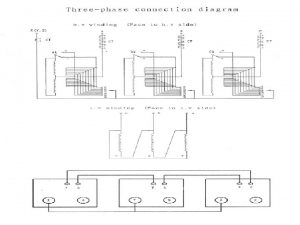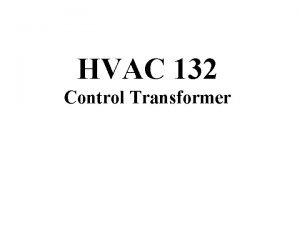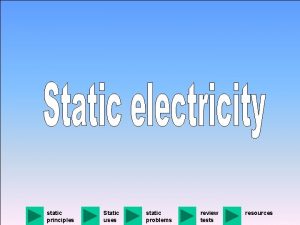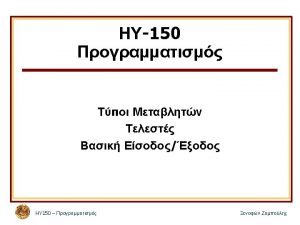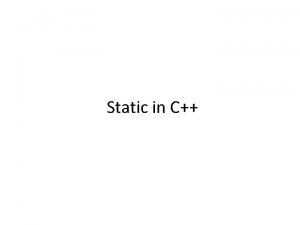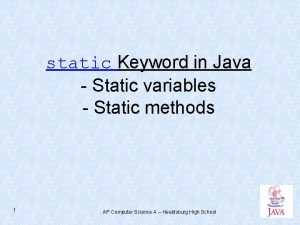Transformer Introduction The transformer is a static device


















































































- Slides: 82

Transformer

Introduction • The transformer is a static device (i. e. the one which does not contain any rotating or moving parts) which is used to transfer electrical energy from one ac circuit to another ac circuit, with increase or decrease in voltage/current but without any change in frequency.

Course outcome C 403. 3: Evaluate efficiency and regulation of a given transformer by conducting load test

Continued…. Function of transformer: • The electrical energy is generated and transmitted at extremely high voltages. The voltage is to be then reduced to a lower value for its domestic and industrial use. • This is done by using a transformer. Thus it is possible to reduced the voltage level using a transformer called step down transformer. • On the other hand, the transformer used to increase the voltage level is called step up transformer. • When the transformer changes the voltage level, it changes the current level also.

Types of Transformer • There are two types of transformer depends on supply system: 1. Single phase transformer 2. Three phase transformer • However the principle of operation for both the types is same.

Principle of Operation • The construction of single phase transformer is as shown in fig. (1 a). It consists of two highly inductive coils (windings) wound on an iron or steel core. • The winding connected to ac supply is called as primary winding whereas the other one is called as the secondary winding. Operating principle of a transformer: 1. As soon as the primary winding is connected to the single phase ac supply, an ac current starts flowing through it.

Continued…. 2. The ac primary current produces an alternating flux ø in the core. 3. Most of this changing flux gets linked with the secondary winding through the core. 4. The varying flux will induce voltage into the secondary winding according to the Faraday’s law of electromagnetic induction. • Thus due to primary current, there is an induced voltage in the secondary winding due to mutual induction. • Hence the induced emf in secondary is called as the mutually induced emf.

Continued…. Can the transformer operate on DC? • Answer is NO. Because with a DC primary current, the flux produced in the core will not alternate, it is of constant value. • As there is no change in flux linkage, the induced emf in secondary winding is zero.

Construction of Transformer • As shown in fig. (1) Basically a transformer consists of two inductive windings and a laminated steel core. • The coils are insulated from each other as well as from the steel core. • A transformer may also consist of a container for winding and core assembly (called as tank), suitable bushings to take our the terminals, oil conservator to provide oil in the transformer tank for cooling purposes etc.

Continued…. Fig. (1): construction of transformer

Continued…. • In all types of transformers, core is constructed by assembling (stacking) laminated sheets of steel, with minimum air-gap between them (to achieve continuous magnetic path). • The steel used is having high silicon content and sometimes heat treated, to provide high permeability and low hysteresis loss. Laminated sheets of steel are used to reduce eddy current loss. • The sheets are cut in the shape as E, I and L. To avoid high reluctance at joints, laminations are stacked by alternating the sides of joint. That is, if joints of first sheet assembly are at front face, the joints of following assemble are kept at back face.

Continued…. Fig. (2): Different cross-sections for transformer limbs

Continued…. • Transformer tank: Ø The whole assembly of large size transformer is placed in a sheet metal tank. Inside the tank the assembly of the transformer is immersed in oil which acts as an insulator as well as coolant. Ø The oil will take out the heat produced by the transformer windings and core and transfer it to the surface of the transformer tank.

Types of transformer • The transformers are of different types depending on the arrangement of the core and windings as follows: 1. Core type 2. Shell type 3. Berry type

Continued…. 1. Core type transformer: Ø The construction of core type transformer is as shown in fig. (1). Fig. (1): core type transformer

Continued…. • It has a single magnetic circuit. The core rectangular having two limbs. The winding encircles the core. The coils used are of cylindrical type. • The coils are wound in helical layers with different layers insulated from each other by paper or mica. Both the coils are placed on both the limbs. • The low voltage coil is placed inside near the core while high voltage coil surrounds the low voltage coil. Core is made up of large number of thin laminations. • As The windings are uniformly distributed over the two limbs, the natural cooling is more effective. The coils can be easily removed by removing the laminations of the top yoke, for maintenance.

Continued…. 2. Shell type transformer: Ø The construction of shell type transformer is as shown in fig. (1). Fig. (2): shell type transformer

Continued…. • It has a double magnetic circuit. The core has three limbs. Both the windings are placed on the central limb. The core encircles most part of the windings. • The coils used are generally multilayer disc type or sandwich coils. Each high voltage coil is in between two low voltage coils and low voltage coils are nearest to top and bottom of the yokes. • The core is laminated. Generally for very high voltage transformers, the shell type construction is preferred. As the windings are surrounded by the core, the natural cooling does not exist. • For removing any winding for maintenance, large number of laminations are required to be removed.

Continued….

EMF equation of a transformer • In a transformer, source of alternating current is applied to the primary winding. • Due to this, the current in the primary winding (called as magnetizing current) produces alternating flux in the core of transformer. • This alternating flux gets linked with the secondary winding, and because of the phenomenon of mutual induction an emf gets induced in the secondary winding. • Magnitude of this induced emf can be found by using the following EMF equation of the transformer.

Continued… • Let, N 1 = Number of turns in primary winding N 2 = Number of turns in secondary winding Φm = Maximum flux in the core (in Wb) = (Bm x A) f = frequency of the AC supply (in Hz) • As, shown in the fig. , the flux rises sinusoidally to its maximum value Φm from 0. It reaches to the maximum value in one quarter of the cycle i. e in T/4 sec (where, T is time period of the sin wave of the supply = 1/f). Therefore, average rate of change of flux = Φm /(T/4) = Φm /(1/4 f) Therefore, average rate of change of flux = 4 f Φm . . . . (Wb/s).

Continued… Fig. (1)

Continued… • Now, Induced emf per turn = rate of change of flux per turn Therefore, average emf per turn = 4 f Φm . . (Volts). • Now, we know, Form factor = RMS value / average value Therefore, RMS value of emf per turn = Form factor X average emf per turn. As, the flux Φ varies sinusoidally, form factor of a sine wave is 1. 11 Therefore, RMS value of emf per turn = 1. 11 x 4 f Φm = 4. 44 f Φm. RMS value of induced emf in whole primary winding (E 1) = RMS value of emf per turn X Number of turns in primary winding E 1 = 4. 44 f N 1 Φm . . . . eq (1)

Continued… • Similarly, RMS induced emf in secondary winding (E 2) can be given as E 2 = 4. 44 f N 2 Φm. . . . . (eq 2) rom the above equations 1 and 2,

Continued… • This is called the emf equation of transformer, which shows, emf / number of turns is same for both primary and secondary winding. • 1. 2. 3. For an ideal transformer on no load, E 1 = V 1 and E 2 = V 2. where, V 1 = supply voltage of primary winding V 2 = terminal voltage of secondary winding Factors affecting the induced emf are: Flux Φm Frequency of applied voltage Number of turns N.

Voltage & Current ratios of a transformer Fig. (1): Elementary single phase transformer

Continued… • Voltage ratios of the transformer with load: Ø As shown in fig. (1), let N 1 = Number of turns in primary winding N 2 = Number of turns in secondary winding E 1 = rms induced voltage in primary winding E 2 = rms induced voltage in secondary winding E 1 = 4. 44 f N 1 Φm volts E 2 = 4. 44 f N 2 Φm volts By taking the ratio of these expressions we get, E 1 …(1) N 1 = N E 2 2

Continued… • Voltage ratios of the transformer without load: Ø Assume the load on secondary winding is disconnected. ∴ I 2 = 0 ∴ load terminal voltage v 2 is equal to secondary induced voltage E 2 i. e. V 2 = E 2 ……. (2) Ø As the primary current on no load is very small, V 1 = E 1 ……. (3) By substituting eq. (2) & (3) in eq. (1) we get, V 1 N = 1 ……(4) V 2 N 2

Continued… • Voltage ratio: The ratio of the primary and secondary terminal voltages (i. e. V 1 & V 2 ) is called as the voltage ratio. • Transformation ratio (k): The transformation ratio for voltage is defined as the ratio of secondary voltage to the primary voltage of a transformer. ∴ K = V 2 = E 2 = N 2 ……(5) V 1 E 1 N 1

Continued… • Turns ratio: The turns ratio of a transformer is defined as the ratio of the number of primary turns to the number of secondary turns. ∴ turns ratio = N 1 ……. (6) N 2 • Types of transformers based on the value of K: 1. Step up transformer: If K > 1 or V 2 > V 1 is called step up transformer. 2. Step down transformer: If K < 1 or V 2 < V 1 is called step down transformer.

Continued… 3. One-to-one transformer: If K=1 or V 1 = V 2 is called as a one-to-one transformer. It is also known as the isolation transformer. • Current ratios: Ø The transformer transfer electrical power from one side to the other (primary to secondary) with a very high efficiency (η). Ø If we assume that the power loss taking place in the transformer is very low (η = 100%) then, we can write that power input = power output ∴ V 1 I 1 cos ø 1 = V 2 I 2 cos ø 2 ……. (7) where I 1 and I 2 are the RMS values of the primary and secondary currents of the transformer respectively.

Continued… Ø cos ø 1 and cos ø 2 are the power factors of the primary and secondary sides of the transformer. Practically they are of same value. ∴ cos ø 1 = cos ø 2 …. . (8) ∴ V 1 I 1 = V 2 I 2 …. . (9) ∴ I 1 V 2 N 2 …. . (10) I 2 = V 1 = N 1 Ø This expression shows that the primary & secondary currents are inversely proportional to the number of turns of the corresponding windings.

Rating of Transformer • Generally the rating of a machine should indicate the power supplied by it. But incase of transformer, the output power is not constant. • It keeps changing with the load. The output power factor is also a function of load. • Hence rating of a transformer is expressed in terms of voltage and current as follows: Rating of transformer = Primary voltage x primary current or = Secondary voltage x secondary current

Continued… • As the voltage and current may or may not be in phase, the units of transformer rating are Volt Ampere (VA) or kilo. Volt-Ampere (k. VA) or Mega Volt Ampere (MVA). ∴ Rating in VA or k. VA or MVA = V 1 x I 1 = V 2 x I 2 • Why is the transformer rated I VA or k. VA? Ø There are two type of losses in a transformer; 1. Copper Losses 2. Iron Losses or Core Losses or Insulation Losses Ø Copper losses ( I²R)depends on Current which passing through transformer winding while Iron Losses or Core Losses or Insulation Losses depends on Voltage.

Continued… Ø Hence the total losses depends on the volt ampere (VA) and not on the power factor. Therefore rating of transformer is in VA or k. VA and not in k. W. • The complete rating of a transformer: Ø The complete rating of a transformer includes the ratio of primary and secondary voltages, k. VA rating and supply frequencies as follows: 3300 V/ 240 V , 5 k. VA , 50 Hz where, 3300 V is primary voltage V 1 240 V is secondary voltage V 2 5 k. VA is k. VA rating and 50 Hz is the supply frequency.

Continued… • Specifications of transformer: Ø When transformer is to be purchased, we have to consider following specifications: 1. k. VA rating 2. Number of phases 3. Primary voltage 4. Secondary voltage 5. Primary current 6. Secondary current 7. Frequency of operation 8. Types of cooling

Continued… Ø table 1 shows the typical specifications of a single phase transformer. Sr. No. Specification/rating Value 1. k. VA rating 5 k. VA 2. Number of phases 1 3. Primary voltage V 1 230 V 4. Secondary voltage v 2 100 V 5. Primary current I 1 21 A 6. Secondary current I 2 50 A 7. Frequency of operation 50 Hz 8. Cooling Open

Losses in a Transformer • An ideal transformer is loss free. But in the practical transformer there are following losses taking place. 1. Copper losses (Pc) 2. Iron losses (Pi): i. Hysteresis losses ii. Eddy current losses

Continued… • Copper Loss (Pc): Ø The total power loss is taking place in the winding resistances of the transformer is known as the copper loss. ∴ Copper loss = Primary copper loss + Secondary copper loss Ø The copper loss is denoted by Pc. where, R 1 and R 2 are resistances of primary and secondary winding respectively.

Continued… Ø The copper loss should be kept as low as possible to increase the efficiency of the transformer. Ø To reduced the copper loss, it is essential to reduce the resistances R 1 and R 2 of primary and secondary winding. Ø Copper losses are also called as variable losses as they are dependent on the square of load current.

Continued… • Iron loss (Pi): Ø Iron loss Pi is the power loss taking place in the iron core of the transformer. Pi = Hysteresis Loss + Eddy current loss • Hysteresis losses: Ø Hysteresis loss is directly proportional to frequency f and voltage V. it is given by PH = KH Bm 1. 67 f. V …. . [KH constant]

Continued… • Eddy current losses: Ø Eddy current loss is proportional to square of frequency and square of thickness of laminations. It is given by, PE = KE Bm 2 f 2. t 2 ……[t = thickness] Ø Due to time varying flux, there is some induced emf in the transformer core. This induced emf causes some currents to flow through the core body. These currents are known as the eddy currents. Ø The eddy current loss can be minimized by using laminated core for transformer.

An Ideal Transformer • An ideal transformer is a transformer having following characteristics: 1. The losses are zero. 2. The primary and secondary winding resistances are zero. 3. The external voltage applied to the primary, V 1 is same as the primary induced voltage E 1. i. e. E 1 = V 1 4. Similarly, the voltage induced E 2 in secondary winding will be equal to the load voltage V 2. i. e. E 2 = V 2 5. . The transformation ratio for an ideal transformer is given by, K = E 2 = V 2 E 1 V 1

Continued… • Efficiency of an ideal transformer is 100%. • The voltage regulation is 0%. That means the secondary voltage will remain constant irrespective of the load current.

Efficiency & Regulation • Efficiency (η): Ø The efficiency of a transformer is defined as the ratio of output power to input power. It is denoted by η. ………………(1)

Continued… Ø Since the output power is always less than the input power due to losses in the transformer, the efficiency of the practical transformer is always between 0 and 1 i. e. 0% and 100% but it can never be 1 or 100%. Ø The output power at full load = V 2 I 2 cos ø 2 or = (k. VA x cos ø 2 x 1000) watt Ø Then from eq. (1), full load efficiency is given by ηFL = k. VA x cos ø 2 x 1000 (k. VA x cos ø 2 x 1000) + Pi + Pc …(2)

Continued… Ø In eq. (2), the value of k. VA and copper loss will change with change in load. Ø The iron loss however remains constant. The copper loss will change in square proportion with the load. Hence for half load condition the efficiency is given by. ηHL = 0. 5 k. VA x cos ø 2 x 1000 (0. 5 k. VA x cos ø 2 x 1000) + Pi +(0. 5)2 Pc

Continued… • Why the transformer efficiency is always higher than that of rotating machines? Ø The transformer is a static device with no moving parts. Hence losses due to friction and windage are completely absent. Ø The efficiency of the transformer can be atleast equal to 90%. Ø This why the transformer efficiency is always higher than the that of rotating machines.

Continued… • Condition for maximum efficiency: It can be proved that the transformer efficiency is maximum when, Pi = Pc i. e. when copper loss equals the iron loss. • Load at maximum efficiency: Ø Let k. VA(max) be the k. VA of the transformer at full load and k. VA(load) be k. VA at a particular load. Let Pi = constant iron loss and Pc = copper loss at full load Ø k. VA load for maximum efficiency is given by, k. VA load for maximum efficiency = k. VA(max) √Pi/Pc

Continued… • Voltage regulation: Ø Ideally, the secondary terminal voltage V 2 (or load voltage) of a transformer should remain constant independent of the load current. Ø But practically the load voltage decreases with increase in load current IL. Ø No load Voltage: The no load voltage is the secondary terminal voltage corresponding to zero load current. For a transformer No load voltage = E 2 volts

Continued… Ø Full load voltage: It is secondary terminal voltage (V 2) corresponding to the specified load current. The percent voltage regulation is given by mathematically as: ……(1) Ø Thus with increase in load current, the value of V 2 decreases and the percent regulation increases. Ideal value of voltage regulation is 0%.

Continued… Ø Definition of voltage regulation: The voltage regulation of a transformer is defined as the change in secondary terminal voltage(V 2) from no load to full load with the primary source voltage (V 1) and the temperature of the transformer maintained constant. The regulation is positive for resistive and inductive loads and it can be negative for the capacitive load.

Load Test • Some of the tests carried out on a transformer are as follows: 1. Direct loading test of load test 2. Open circuit (O. C. ) test 3. Short circuit (S. C. ) test 4. Polarity test • Efficiency measurement: % η = output power delivered to load x 100 input power to the primary

Continued… • Regulation measurement: % Regulation = V 2 NL – V 2 FL x 100 V 2 NL • Advantages of a two winding transformer: 1. It provides complete isolation between primary and secondary. 2. It has no moving parts. 3. Its construction is simple. 4. We can step up or step down the voltage.

Continued… • Disadvantages: 1. Large size. 2. Low efficiency. 3. Poor voltage regulation. 4. High power losses in the windings. 5. More copper is required to be used because it has two separate windings. 6. Variable output voltage can not be obtained. 7. Variable frequency operation is not possible.

Continued… • Applications of two winding transformer: 1. As the distribution transformer. 2. As isolation transformer. 3. As a step down transformer in the dc power supplies. 4. Welding applications.

Autotransformer • The normal transformer has separate primary and secondary windings. • But the autotransformer is a special transformer in which a part of winding is common for the primary and secondary windings. • The construction of autotransformer is as shown in fig. (1). • It consists of only one winding wound on a laminated magnetic core, with rotary movable contact. Thus form the autotransformer three terminals are brought out for connection. • The autotransformer can operate as a step down or a step up transformer.

Continued… Fig. (1): Autotransformer

Continued… • Autotransformer as step down transformer: Ø Fig. 2(b) shows the connection of autotransformer as step down transformer. Ø It shows that two terminal A and B are connected to the single phase AC supply V 1. thus winding AB acts as the primary winding. Ø A part of complete winding i. e. CB acts as the secondary winding across which the load is connected.

Continued… Fig. 2(a): Step down autotransformer fig. 2(b): step down autotransformer

Continued… Ø The load voltage for this configuration is given by, V 2 = N 2 x V 1 N 1 Ø As the number of turns N 2 is less than N 1, this configuration operates as step down transformer.

Continued… • Autotransformer as step down transformer: Ø Fig. 2(b) shows the connection of an autotransformer for operating as the step up transformer. Ø It shows the part CB of the complete winding acts as the primary winding. The full winding AB acts as a secondary winding and the load is connected between these terminals. Ø As the number of turns N 2 is higher than the number of turns N 1, the autotransformer acts as a step up transformer.

Continued… • Advantages of autotransformer: 1. As only one winding is used, the copper required for the transformer is very less. 2. The size and hence cost is reduced as compared to the conventional transformer. 3. The losses taking place in the winding are reduced hence the efficiency is higher than the conventional transformer. 4. Due to reduced resistance, the voltage regulation is better than the conventional transformer.

Continued… • Disadvantages of autotransformer: 1. There is no electrical isolation between the primary and secondary winding. This can be proved to be dangerous for high voltage applications. 2. If common part of the winding breaks, then transformer action is lost and full primary voltage appears across the secondary. 3. It possess a low impedance, hence if the secondary circuit is short circuited, then large current will flow on the secondary side.

Continued… • Applications of autotransformer: 1. It can be used as a variac, i. e. variable ac supply to vary the ac voltage applied to the load smoothly from 0 V to about 270 V. 2. In order to start the ac machines such as induction motors or synchronous motors. 3. To vary the supply voltage (as per requirement) of a furnace. 4. As a dimmerstat: when the variac autotransformer is used to control the intensity of lamps in the cinema halls etc. , it is called as the dimmerstat.

Continued… • Comparison of two winding transformer and autotransformer: Sr. no. Parameter Autotransformer Conventional transformer Definition A transformer, having only one winding a part of which acts as a primary and the other as a secondary. It is a static machine which transfers electrical energy from one end to another without changing frequency. Number of Windings Auto-transformer has only one winding wound on a laminated core It has two separate winding, i. e. , primary and secondary winding. Insulation The primary and secondary winding are not electrically insulated. The primary and secondary winding are electrically insulated from each other. 1. 2. 3.

Continued… Sr. no. Parameter Autotransformer Conventional transformer 4. Induction Self Induction Mutual Induction 5. Size Small Large Power Transfer Partly by transformation and partly by direct electrical Through transformation connection. 7. Voltage Regulation Better Good 8. Winding Material Less requires More requires Circuit The primary and secondary winding circuits are connected magnetically. The primary and secondary winding circuits are connected both electrically and magnetically. 10. Connection Depends upon the tapping Connect directly to the load. 11. Starting current Decreases by 1/3 times. 6. 9.

Continued… Sr. no. Parameter Autotransformer Conventional transformer 12. Excitation current Small Large 13. Economical More Less 14. Cost Less costly More costly 15. Efficient More Less 16. Leakage flux and resistance Low High 17. Impedance Less High 18. Cost Cheap Very costly 19. Losses Low High 20. Output voltage Variable Constant. Applications Use as a starter in an induction Use in power system for motor, as a voltage regulator, step up and step down the in railways, in a laboratory. voltage. 21.

Three Phase Transformer • The electric power is generally generated in the form of three phase voltage. The distribution of the electric power also is three phase. • The voltage generation takes place at very high level typically at 13. 2 k. V or 22 k. V or even higher. The transmission of electricity takes place at voltage level such as 110 k. V, 132 k. V. • So it is necessary to use the step up transformer to raise the voltage levels from 13. 2 k. V to 132 k. V etc. The three phase transformer are used for the same. • Such high voltages can not be used by the domestic or industrial users. So the voltage should be stepped down. Three phase step down transformer are used as distribution transformer.

Continued… • Construction of three phase transformer: Ø The three phase transformer were constructed by combining three single phase transformer as shown in fig. (1). Ø The three single phase transformer are connected such that the three primary windings are connected in delta or star. Ø This type of construction is called as the bank of the transformer.

Continued… Ø Similarly, the secondary windings are connected in star or delta as shown in fig. (1). Ø But such construction proves to be costly and makes the transformer bulky. Therefore, specially made three phase transformer are being used now a days.

Fig. (1)construction of three phase transformer

Continued… • Advantages: Ø The advantages of using bank of single phase transformer are as follows: 1. Reliability is equally good as that of a 3 phase single unit transformer. 2. It is cheaper to carry spare stock of a sign phase transformer. 3. In the underground (mine) applications, the bank is preferred due to case of transport. 4. The bank also gives an advantages of derated open delta operation if one unit out of three become inoperative.

Continued… • Disadvantages: 1. The bank of transformers cost more. 2. It occupies more space. 3. The three phases are electrically connected but the three magnetic circuits are independent.

Continued… • Types of three phase transformer: Ø The three phase transformers are of two types: 1. Core type 2. Shell type

Continued… 1. Core type transformer: • Fig. (2) shows the construction of core type transformer. • The core of this transformer consists of three limbs. The primary and secondary windings of the three phases are wound on these limbs.

Continued… Fig. (2): construction of core type three phase transformer

Continued… 2. Shell type transformer: • The construction of shell type transformer is as shown in fig. (3). • The construction of three phase shell type transformer is similar to that of a single phase shell type transformer.

Continued… Fig. (2): construction of shell type three phase transformer

Continued… • Three phase transformer connection: Ø There are several methods of connecting primaries and secondaries of three phase transformer. They are: 1. Star-star connection 2. Delta-delta connection 3. Star-delta connection 4. Delta-star connection 5. Vee-Vee or open delta 6. Tee-Tee or Scott

Continued… Ø These connections may be step-up or stepdown. Ø Out of these transformer the delta-star type transformer is most commonly used for the distribution applications.

Continued… • Specifications/ratings of 3 phase transformer: Sr. No. Specifications/Ratings Value 1. k. VA rating 50 k. VA 2. Number of phases 3 3. Connection Delta/star 4. Primary voltage 415 V 5. Secondary voltage 230 V 6. Primary current 70 A 7. secondary current 126 A 8. Cooling Open 9. Frequency 50 Hz
 What is a static device
What is a static device Why transformer is static device
Why transformer is static device Input device output device storage device
Input device output device storage device Differences between ideal and practical transformer
Differences between ideal and practical transformer Condition for maximum efficiency of transformer
Condition for maximum efficiency of transformer Transformer is a device which
Transformer is a device which Ac device
Ac device All day efficiency
All day efficiency Asim kadav
Asim kadav A tagout device is preferable to using a lockout device.
A tagout device is preferable to using a lockout device. Kelompok output device
Kelompok output device Condition for maximum efficiency of transformer
Condition for maximum efficiency of transformer Hát kết hợp bộ gõ cơ thể
Hát kết hợp bộ gõ cơ thể Slidetodoc
Slidetodoc Bổ thể
Bổ thể Tỉ lệ cơ thể trẻ em
Tỉ lệ cơ thể trẻ em Voi kéo gỗ như thế nào
Voi kéo gỗ như thế nào Tư thế worms-breton
Tư thế worms-breton Alleluia hat len nguoi oi
Alleluia hat len nguoi oi Môn thể thao bắt đầu bằng chữ f
Môn thể thao bắt đầu bằng chữ f Thế nào là hệ số cao nhất
Thế nào là hệ số cao nhất Các châu lục và đại dương trên thế giới
Các châu lục và đại dương trên thế giới Công thức tiính động năng
Công thức tiính động năng Trời xanh đây là của chúng ta thể thơ
Trời xanh đây là của chúng ta thể thơ Mật thư tọa độ 5x5
Mật thư tọa độ 5x5 Làm thế nào để 102-1=99
Làm thế nào để 102-1=99 độ dài liên kết
độ dài liên kết Các châu lục và đại dương trên thế giới
Các châu lục và đại dương trên thế giới Thơ thất ngôn tứ tuyệt đường luật
Thơ thất ngôn tứ tuyệt đường luật Quá trình desamine hóa có thể tạo ra
Quá trình desamine hóa có thể tạo ra Một số thể thơ truyền thống
Một số thể thơ truyền thống Cái miệng xinh xinh thế chỉ nói điều hay thôi
Cái miệng xinh xinh thế chỉ nói điều hay thôi Vẽ hình chiếu vuông góc của vật thể sau
Vẽ hình chiếu vuông góc của vật thể sau Thế nào là sự mỏi cơ
Thế nào là sự mỏi cơ đặc điểm cơ thể của người tối cổ
đặc điểm cơ thể của người tối cổ Giọng cùng tên là
Giọng cùng tên là Vẽ hình chiếu đứng bằng cạnh của vật thể
Vẽ hình chiếu đứng bằng cạnh của vật thể Fecboak
Fecboak Thẻ vin
Thẻ vin đại từ thay thế
đại từ thay thế điện thế nghỉ
điện thế nghỉ Tư thế ngồi viết
Tư thế ngồi viết Diễn thế sinh thái là
Diễn thế sinh thái là Các loại đột biến cấu trúc nhiễm sắc thể
Các loại đột biến cấu trúc nhiễm sắc thể Số nguyên là gì
Số nguyên là gì Tư thế ngồi viết
Tư thế ngồi viết Lời thề hippocrates
Lời thề hippocrates Thiếu nhi thế giới liên hoan
Thiếu nhi thế giới liên hoan ưu thế lai là gì
ưu thế lai là gì Hươu thường đẻ mỗi lứa mấy con
Hươu thường đẻ mỗi lứa mấy con Sự nuôi và dạy con của hổ
Sự nuôi và dạy con của hổ Hệ hô hấp
Hệ hô hấp Từ ngữ thể hiện lòng nhân hậu
Từ ngữ thể hiện lòng nhân hậu Thế nào là mạng điện lắp đặt kiểu nổi
Thế nào là mạng điện lắp đặt kiểu nổi Introduction to static equilibrium mastering physics
Introduction to static equilibrium mastering physics Input device introduction
Input device introduction Essay structure introduction
Essay structure introduction Ethertype 88b5
Ethertype 88b5 277 480 transformer bank
277 480 transformer bank Dielectric absorption ratio ieee
Dielectric absorption ratio ieee Transformer efficiency formula
Transformer efficiency formula Efficiency of transformer
Efficiency of transformer Two stage transformer coupled amplifier
Two stage transformer coupled amplifier Emf equation of transformer
Emf equation of transformer Transformer fitting
Transformer fitting Buck boost transformer seminar report
Buck boost transformer seminar report Step up transformer definition
Step up transformer definition Maximum efficiency of transformer
Maximum efficiency of transformer Dead front vs live front transformer
Dead front vs live front transformer Bakiss
Bakiss Efficiency of half wave rectifier
Efficiency of half wave rectifier Wye transformer bank
Wye transformer bank Reformer: the efficient transformer
Reformer: the efficient transformer Transformer conservator airbag
Transformer conservator airbag Simbol pengubah
Simbol pengubah 120/208 wye wye bank
120/208 wye wye bank Copper loss in transformer formula
Copper loss in transformer formula Disadvantages of current transformer
Disadvantages of current transformer Functions of transformers
Functions of transformers Magnetically coupled coils
Magnetically coupled coils Ac theory 2 lesson 8
Ac theory 2 lesson 8 Transformer overview
Transformer overview Transformer jesus
Transformer jesus



